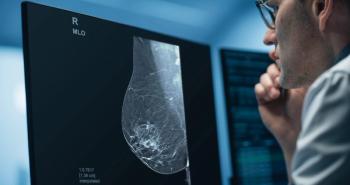
Breast Density Estimations in Standard-dose, Synthetic Mammograms
Breast percentage density estimations with synthesized 2D breast imaging versus standard-dose mammograms.
Synthesized digital breast tomosynthesis (DBT) images are generally comparable to images from standard-dose mammograms, according to a study published in
Researchers from the University of Pennsylvania in Philadelphia compared the quality and agreement between automated estimates of breast density made from standard-dose versus synthetic digital mammograms among women undergoing breast cancer screening.
The researchers evaluated images taken from 3,668 negative digital breast tomosynthesis (DBT) screening examinations consecutively performed over a four-month period, in which both standard-dose and synthesized mammograms were available. Agreement between density estimates was assessed by using Pearson correlation, linear regression, and Bland-Altman analysis. Differences were evaluated by using the paired Student t test.
Results showed that breast percentage density (PD) estimates from synthetic and standard-dose mammograms were highly correlated, and the 95% Bland-Altman limits of agreement between PD estimates were −6.4% to 9.9%. Synthetic mammograms had PD estimates by an average of 1.7% higher than standard-dose mammograms, with a larger disagreement by 1.56% in women with highly dense breast tissue.
“Fully automated estimates of breast density made from synthetic mammograms are generally comparable to those made from standard-dose mammograms,” the researchers concluded. “This may be important, as standard two-dimensional mammographic images are increasingly being replaced by synthetic mammograms in DBT screening in an attempt to reduce radiation dose.”
Newsletter
Stay at the forefront of radiology with the Diagnostic Imaging newsletter, delivering the latest news, clinical insights, and imaging advancements for today’s radiologists.



























